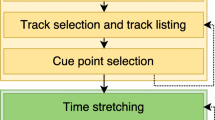Abstract
This paper presents MusicMixer, an automatic DJ system that mixes songs in a seamless manner. MusicMixer mixes songs based on audio similarity calculated via beat analysis and latent topic analysis of the chromatic signal in the audio. The topic represents latent semantics about how chromatic sounds are generated. Given a list of songs, a DJ selects a song with beat and sounds similar to a specific point of the currently playing song to seamlessly transition between songs. By calculating the similarity of all existing pairs of songs, the proposed system can retrieve the best mixing point from innumerable possibilities. Although it is comparatively easy to calculate beat similarity from audio signals, it has been difficult to consider the semantics of songs as a human DJ considers. To consider such semantics, we propose a method to represent audio signals to construct topic models that acquire latent semantics of audio. The results of a subjective experiment demonstrate the effectiveness of the proposed latent semantic analysis method.
Access this chapter
Tax calculation will be finalised at checkout
Purchases are for personal use only
Similar content being viewed by others
Notes
- 1.
The word “mix” here refers to the gradual transiton of one song to another.
References
Blei, D., Ng, A., Jordan, M.: Latent dirichlet allocation. J. Mach. Learn. Res. 3, 993–1022 (2003)
Ishizaki, H., Hoashi, K., Takishima, Y.: Full-automatic DJ mixing system with optimal tempo adjustment based on measurement function of user discomfort. In: Proceedings of ISMIR, pp. 135–140 (2009)
Platt, J. Burges, C., Swenson, S., Weare, C., Zheng, A.: Learning a gaussian process prior for automatically generating music playlists. In: Proceedings of NIPS, pp. 1425–1432 (2001)
Aucouturier, J.J., Pachet, F.: Scaling up music playlist generation. In: Proceedings of ICME, pp. 105–108 (2002)
Pampalk, E., Pohle, T., Widmer, G.: Dynamic playlist generation based on skipping behavior. In: Proceedings of ISMIR, pp. 634–637 (2005)
Ragno, R., Burges, C., Herley, C.: Inferring similarity between music objects with application to playlist generation. In: Proceedings of MIR, pp. 73–80 (2005)
Goto, M., Goto, T.: Musicream: integrated music-listening interface for active, flexible, and unexpected encounters with musical pieces. Inf. Media Technol. 5(1), 139–152 (2010)
Davies, M., Hamel, P., Yoshii, K., Goto, M.: AutoMashUpper: automatic creation of multi-song music mashups. Trans. Audio Speech Lang. Process. 22(12), 1726–1737 (2014)
Tokui, N.: Massh!: a web-based collective music mashup system. In: Proceedings of DIMEA, pp. 526–527 (2009)
Sasaki, S., Yoshii, K., Nakano, T., Goto, M., Morishima, S.: LyricsRadar: a lyrics retrieval system based on latent topics of lyrics. In: Proceedings of ISMIR, pp. 585–590 (2014)
Sivic, J., Zisserman, A.: Video Google: a text retrieval approach to object matching in videos. In: Proceedings of ICCV, pp. 1470–1477 (2003)
Nakano, T., Yoshii, K., Goto, M.: Vocal timbre analysis using latent Dirichlet allocation and cross-gender vocal timbre similarity. In: Proceedings of ICASSP, pp. 5202–5206 (2014)
Hu, D., Saul, L.: A probabilistic topic model for unsupervised learning of musical key-profiles. In: Proceedings of ISMIR, pp. 441–446 (2009)
Hu, D., Saul, L.: A probabilistic topic model for music analysis. In: Proceedings of NIPS (2009)
Goto, M.: Development of the RWC music database. In: Proceedings of ICA, pp. 553–556 (2004)
Hirai, T., Sasaki, S., Morishima, S.: MusicMean: fusion-based music generation. In: Proceedings of SMC, pp. 323–327 (2015)
Acknowledgments
This work was supported by OngaCREST, CREST, JST and JSPS Grant-in-Aid for JSPS Fellows. This work was inspired by Tonkatsu DJ Agetaro.
Author information
Authors and Affiliations
Corresponding author
Editor information
Editors and Affiliations
Rights and permissions
Copyright information
© 2016 Springer International Publishing Switzerland
About this paper
Cite this paper
Hirai, T., Doi, H., Morishima, S. (2016). MusicMixer: Automatic DJ System Considering Beat and Latent Topic Similarity. In: Tian, Q., Sebe, N., Qi, GJ., Huet, B., Hong, R., Liu, X. (eds) MultiMedia Modeling. MMM 2016. Lecture Notes in Computer Science(), vol 9516. Springer, Cham. https://doi.org/10.1007/978-3-319-27671-7_59
Download citation
DOI: https://doi.org/10.1007/978-3-319-27671-7_59
Published:
Publisher Name: Springer, Cham
Print ISBN: 978-3-319-27670-0
Online ISBN: 978-3-319-27671-7
eBook Packages: Computer ScienceComputer Science (R0)




